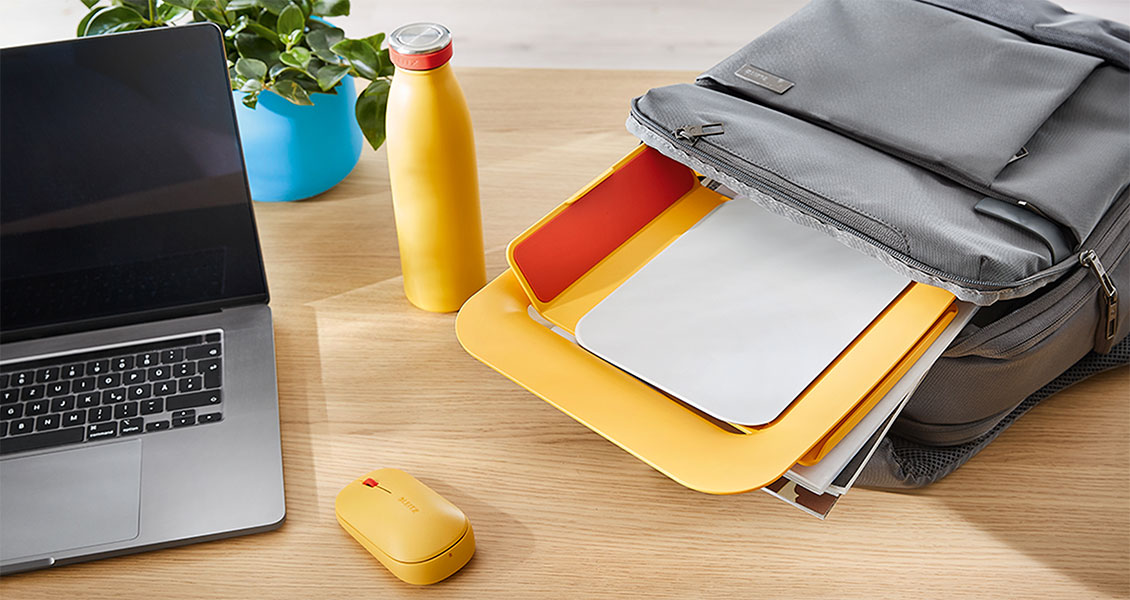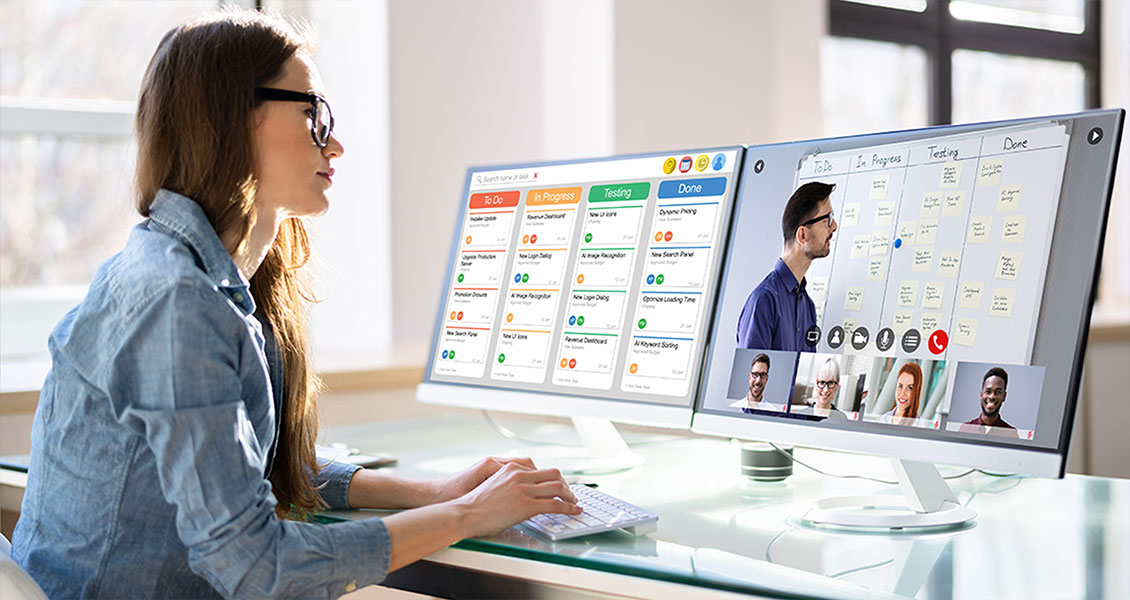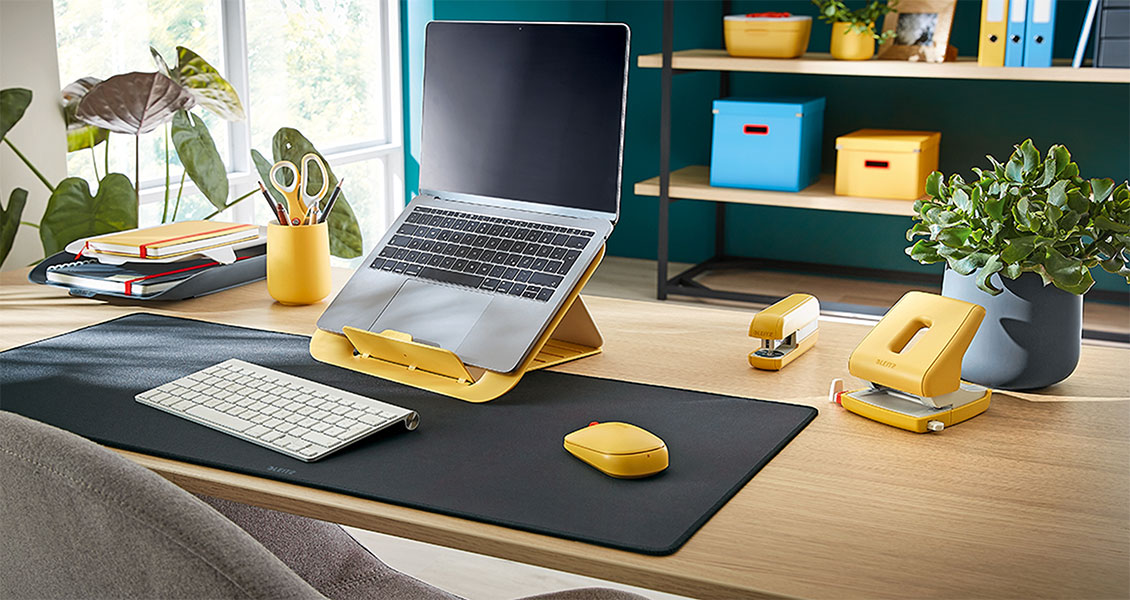Tips to Work Productively When Hybrid Working
19.12.2022

Hybrid working offers a whole host of benefits, with more flexible working and a better work life balance. However, it’s important that it’s approached in the right way, to ensure we can work productively and maintain our organisation at home and in the office. From getting the right work from home essentials to organising your tasks, below are our tips and best practices for efficient hybrid working.
Set up your workstations to suit you
It’s important when hybrid working to ensure both the workstation at home and your workstation in the office are set up correctly. Think about your preferred way of working and what equipment you will need to complete your tasks.
For some, it will be helpful to replicate their office workstation at home. This can make for a smooth and easy transition when hybrid working. If you’ll be doing the same kinds of work between both locations, you should not only think about what equipment you need but also how it’s laid out. If you have letter trays to the left of your monitor in the office, make sure you have the same for your home office.
Other people may plan on doing different tasks while they’re at home and in the office. So, they will need different workstation setups. If this applies to you, think about what equipment you will need in which location. If you don’t plan on working with paper documents at home, you probably won’t need filing equipment. However, you might still need a notebook or desk memo board to take notes as you work.
Remember ergonomics
Ergonomics is just as important for your home office setup as it is for your office workstation. When you’re organising your workstations, think about what you will use and what ergonomic equipment can help you to work comfortably and safely.
If you’re taking a laptop between the home and office, it can be beneficial to use a laptop stand. This will raise the screen to a comfortable viewing height so you can maintain a good posture while you work. You’ll also need to use a separate keyboard and mouse, to avoid injury to your wrists. If you’re using a PC and/or multiple screens, a monitor riser will help to keep them at the correct height.
The office chair you use both at home and in the office should have adequate lumbar support and preferably be adjustable, so you can work at the correct height and posture. You could also look at a sit stand desk. This will allow you to keep active whilst you work. Our standing desk converters from Leitz make it easy to transition between sitting and standing, and they have a small footprint to take up less space. This makes them ideal for home working and your home office setup.

Consider mobile equipment
If you plan on travelling between home and the office with your equipment, you should look for tools that are easy to transport. For example, our laptop stands fold flat so they can easily be transported in a laptop bag along with your laptop. You should also consider a wireless mouse and headset which can be taken between multiple locations with ease.
However, you should also consider when it might make sense to double up on equipment. This can save you time when you’re packing up your workstation at the end of the day and getting ready to move to another location. For example, it might be more practical to have a wireless charger at home and another in the office, so you don’t have to unplug it every time you move locations.
If you don’t have a permanent desk in the office due to a hot desking policy, it might still be beneficial to have some equipment that stays in the office. In that situation, you might need your own storage carry box. You can use this to store the items in the office you need to set up your workstation, to minimise what you need to take home.

Plan your week
For productive hybrid working, you should aim to plan ahead each week and create a schedule. You should think about what tasks you need to complete that week and where it will be most efficient to conduct them.
If you have tasks that require collaborative working, it will probably be better to save them for when you’re in the office. Similarly, if you have tasks that require you to work alone or need a focused environment, it might be best to save them for home working.
Create a schedule in your calendar so you can block out time for each day depending on where you are and what needs to be completed. Make notes of any project deadlines or milestones that need to be kept. You should allow some flexibility in your schedule in case any last-minute tasks come up that you weren’t able to plan for.

Keep your desks tidy
An important part of effective hybrid working is keeping organised, both at home and in the office. To do this, you should take the time to keep your workstations tidy. An organised desk will help you to work productively.
You should take care to keep your equipment stored in the right place, so everything is easy to find when you need it. Think about what you might need to help with keeping things tidy. Perhaps you need desk storage, or maybe you need separate storage boxes for your office organising.
It can be helpful at the end of every day to tidy your workstation and return everything to its right place. This can make it easier when you come back to that location to work, as you’ll know everything is where it should be. It can also make for a more positive working environment when you tidy away any clutter.
Keep your documents organised – both digital and paper
The key to working productively when you’re hybrid working is making sure your files are easily accessible, no matter where you are. Your company may already have a cloud storage system in place, where you can store your files and access them from the office and at home.
It’s important to keep this storage system properly organised. You should file your documents in a manner that will make sense to you and also your colleagues, so documents can easily be found when they’re needed. Using online storage for your documents also minimise losing any paperwork as you move between the office and home.
It won’t always be possible to completely avoid hard copies of your paperwork. So, you should make sure you have efficient home file storage as well as filing in the office. It can be helpful to replicate the filing system you have in the office at home, so you know exactly where your documents should go and where they can be found.
If you’ll be working with confidential documents at home, think about how you will dispose of them when they’re no longer needed. It can be more secure to invest in a home paper shredder, so you can safely destroy confidential documents and not risk a data breach by transporting them between the home and office.

Communicate with colleagues
You can help your colleagues with their own hybrid working schedules by keeping in communication with them. They should know when you plan to be in the office and when you’ll be at home, and you should make sure you know where they plan to work too. This will help everyone to schedule their time to work most productively.
It might be that you have set days that you will work from home, or perhaps it will change every week. Either way, keep in contact with your co-workers so they know what’s going on. You could use an instant messaging app like Teams or Slack to check in every day or every week and update your team with your whereabouts. Or you could use a shared calendar so everyone can see where everyone will be on a given day.
When you organise meetings, be aware that not everyone might be in the office at the same time. Make sure to incorporate ways people can join remotely, through video calls or the telephone, so no one has to miss out.
Analyse and evaluate
It’s important to monitor what’s successful and what isn’t when you’re hybrid working. You should take some time periodically to reflect on any challenges that you’ve faced due to working between multiple locations.
For example, if you find you’ve wasted a lot of your day setting up your equipment or packing up at the end of the day, it might be beneficial to buy extra tools to keep in each location. Or, if you find that your desk gets covered in documents when you’re working from home, you might need filing to help with organising your paperwork at home.
You should take the necessary steps to improve your hybrid working practices, to ensure you can continue to work productively and efficiently.
Leitz has a huge range of home office essentials and office stationery so you can work effectively no matter your location.
Read more about making the most of remote working:
What Do You Need for the Best Ergonomic Home Office Setup?